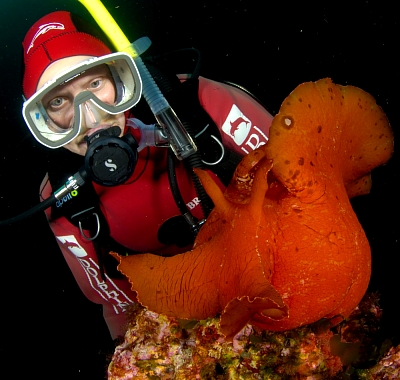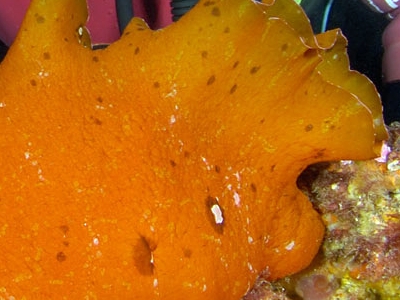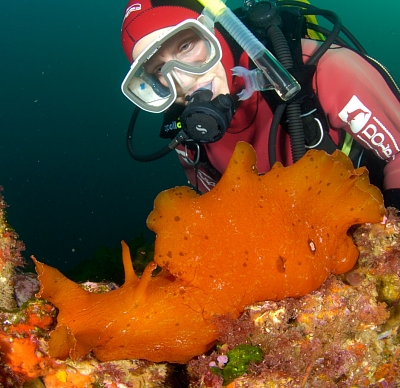Aplysia sagamiana from Poor Knights Ids, NZ.
April 18, 2006
From: Ross Armstrong


Dear Bill,
Diane and I found another "giant" seahare at the Poor Knights on Friday. The pictures showing the diver (Diane) were taken with a fisheye lens so there is a little bit of perspective distortion. It was not quite as large as the seahare we found in Rikoriko cave but still pretty large, I would estimate it to be bigger than 350 mm. I found it amoung some kelp on a wall just below where the picture was taken. I moved it to this place to get some better pictures. It did not seem too concerned and continued feeding on some sea lettuce (Ulva sp.) as shown in Diane's photo. I also tried to see if it would swim by releasing it in open water - a bit questionable in a marine reserve but hopefully with the right (scientific) purpose in mind. Unfortunately it shows not the slightest sign of swimming and just sunk slowly. We have now seen three seahares that were of a similar size and colouration. I have not seen any of them swim. They all had distinct white spots on their sides which you can see in the third picture.
Locality: Poor Knights Islands, 10 m, Northland, New Zealand, South Pacific Ocean, 14 April 2006, Rocky reef wall. Length: > 350 mm. Photographer: Ross Armstrong.
Best regards,
Ross Armstrong
ross@oceanwildlife.com
Armstrong, R.W., 2006 (Apr 18) Aplysia sagamiana from Poor Knights Ids, NZ.. [Message in] Sea Slug Forum. Australian Museum, Sydney. Available from http://www.seaslugforum.net/find/16368
Dear Ross,
Since your earlier two records of this species [messages #14048, #14063] from New Zealand I have had a photo from Anne Gilmore [#15867] of what must be the same species, and which I suggested may be Aplysia sagamiana. Her animal was quite a bit smaller than your specimens and so I had no difficulty in identfying it with specimens I have from eastern Australia which look very like A. sagamiana from Japan.
As you say, the white spots, encircled with a brown ring, are a very distinctive feature of your animals and are also present in those smaller ones I have considered to be A. sagamiana. Despite your friend saying he saw one of your large sea hares swimming, your experiences suggest it doesn't. From your photos here, it also has the parapodia joining posteriorly quite high above the body. I am pretty sure now that it is not A. extraordinaria. Baba described A. sagamiana as a 'small Aplysia' growing to about 70 mm, but he had information on only a few specimens so it is possible he was looking at juveniles of a much larger species. At this stage A. sagamiana is the only species with these distinctive white spots surrounded by dark brown rings, so I will tentatively identify your animals as that species.until we know more about it from Japan.
Best wishes,
Bill Rudman
Related messages
-
Another large seahare from New Zealand
From: Ross Armstrong, April 24, 2007 -
Re: Aplysia sagamiana from Poor Knights Ids, NZ.
From: Ross Armstrong, April 24, 2006 -
Re: Aplysia sagamiana from Poor Knights Ids, NZ.
From: Ross Armstrong, April 18, 2006 -
Aplysia sagamiana at the Poor Knights, New Zealand
From: Ann Gilmore, February 18, 2006 -
Re: Aplysia extraordinaria from New Zealand
From: Ross Armstrong, June 15, 2005 -
Aplysia extraordinaria from New Zealand
From: Ross Armstrong, June 14, 2005
